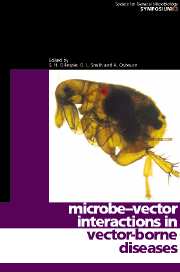Book contents
- Frontmatter
- Contents
- Contributors
- Editors' Preface
- 1 Vector-borne diseases
- 2 Evolution of tick-borne disease systems
- 3 Insect transmission of viruses
- 4 RNA-based immunity in insects
- 5 Specificity of Borrelia–tick vector relationships
- 6 Bunyavirus/mosquito interactions
- 7 How do mosquito vectors live with their viruses?
- 9 Vector competence
- 9 Environmental influences on arbovirus infections and vectors
- 10 Vector immunity
- 11 Transmission of plant viruses by nematodes
- 12 Wolbachia host–symbiont interactions
- 13 Pathogenic strategies of Anaplasma phagocytophilum, a unique bacterium that colonizes neutrophils
- 14 Interactions of Yersinia pestis with its flea vector that lead to the transmission of plague
- 15 Transgenic malaria
- 16 Vaccines targeting vectors
- Index
Editors' Preface
Published online by Cambridge University Press: 06 July 2010
- Frontmatter
- Contents
- Contributors
- Editors' Preface
- 1 Vector-borne diseases
- 2 Evolution of tick-borne disease systems
- 3 Insect transmission of viruses
- 4 RNA-based immunity in insects
- 5 Specificity of Borrelia–tick vector relationships
- 6 Bunyavirus/mosquito interactions
- 7 How do mosquito vectors live with their viruses?
- 9 Vector competence
- 9 Environmental influences on arbovirus infections and vectors
- 10 Vector immunity
- 11 Transmission of plant viruses by nematodes
- 12 Wolbachia host–symbiont interactions
- 13 Pathogenic strategies of Anaplasma phagocytophilum, a unique bacterium that colonizes neutrophils
- 14 Interactions of Yersinia pestis with its flea vector that lead to the transmission of plague
- 15 Transgenic malaria
- 16 Vaccines targeting vectors
- Index
Summary
Vector-borne diseases are a major threat to public health throughout the world. They include major human diseases such as malaria, trypanosomiasis and dengue, and others that principally affect animal populations such as theileriosis and West Nile fever. The study of vector-borne diseases has gone through a period when there was little impetus for research. However, through programmes such as the ‘Great Neglected Diseases Network’ and the Tropical Diseases Research Programme of WHO in the 1980s scientific attention was redirected to vector-borne diseases. More recently initiatives such as the ‘Roll Back Malaria’ programme have moved the subject on further.
In industrialized countries vector-control programmes have eradicated the important vector-borne diseases although increasing international travel has meant that diseases acquired in the tropics are no longer rare in developed world clinical practice. Climate change, industrialization, changing land use and increasing population have all had a profound impact on vector-borne diseases, resulting in epidemics spread. The recent appearance of West Nile virus in North America and Nipah virus in Malaysia has been responsible for dramatic epidemics in animal and human populations with considerable numbers of human deaths. These epidemics have caught the attention of the public.
Vector-borne infections require an extraordinary integration of host and pathogen. Unravelling these interrelationships is a challenge for biologists. The subtle ways in which parasites control their vectors, and the filaria that contain Wolbachia spp., essential to survival and fertility, are examples of elegant and effective co-evolution.
This symposium volume brings together internationally recognized experts to explore the complexity of host–pathogen–vector interactions.
- Type
- Chapter
- Information
- Microbe-vector Interactions in Vector-borne Diseases , pp. xi - xiiPublisher: Cambridge University PressPrint publication year: 2004



